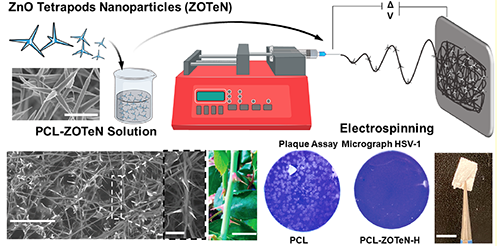| Oct 12, 2021 | |
Spiky rose thorns inspire nanoengineered antiviral herpes treatment |
|
| (Nanowerk Spotlight) Herpes simplex is a viral infection caused by the herpes simplex virus (HSV). Worldwide rates of either HSV-1 (associated with mostly oral and eye infections) or HSV-2 (associated with genital diseases) are between 60% and 95% in adults. There is no available vaccine and once infected, there is no cure. | |
| In previous work, researchers have demonstrated HSV virus-trapping, tetrapod-shaped zinc-oxide nanoparticles (called ZOTeN) that provide a synergistic microbicidal effect and vaccine treatment against primary and secondary female genital herpes infections. | |
| Building on this earlier study, researchers have now developed an antiviral dressing material with visible-light-activated sterilizing properties that enables physical and chemical protection against viral agents. | |
| They report their findings in ACS Materials Letters ("Nanoengineered Antiviral Fibrous Arrays with Rose-Thorn-Inspired Architectures"). | |
| "We hypothesized that these ZOTeN rose-thorn-like protrusions generate antiviral properties when incorporated into non-woven fibrous mats that could provide topical treatment for HSV and could be deployed as antiviral garments, or face coverings, in viral outbreaks," the paper's first author Amir Nasajpour, a PhD Research Assistant at the California NanoSystems Institute at UCLA and member of the Paul S. Weiss research group, tells Nanowerk. | |
 |
|
| The fabrication scheme for the electrospun zinc oxide tetrapod nanoparticles (ZOTeN) ZnO-laden nanofibers is developed with a 2% ZOTeN weight per volume (w/v), 4% (w/v) ZOTeN solution, a 12% (w/v) polycaprolactone (PCL)-ester-terminated hexafluoroisopropanol solution spun using a conventional electrospinning setup. Scale bars are 3 µm for the ZOTeN particles, 100 µm for the electrospun structure, 20 µm for rose-thorn- shaped material scanning electron micrograph, and 2 mm for the actual rose digital photograph. (Reprinted with permission by American Chemical Society) (click on image to enlarge) | |
| The researchers re-engineered a common additive agent found in sunscreen (zinc oxide –ZnO) to be self-sterilizing within a non-woven fibrous mats for herpes virus treatment. The self-sterilizing function creates a 'green' associated oxidant hydrogen peroxide (hydrogen peroxide – H2O2), capable of eliminating harmful bacteria and viruses. | |
| The team anticipates that their engineered mats can be used for manufacturing antiviral garments, face coverings, bandages, antiviral coatings, etc. | |
| Specifically, these fabrics can be used to treat HSV-1 topically – to provide a physical barrier and to neutralize the viral particles to stop their spread. | |
| The materials also provide light-activated self-sterilization. | |
| "We engineered a sterilizing mechanism via blue light (405 nm) excitation: under illumination, this process excites electrons to the conduction band, producing electron−hole pairs on the ZOTeN surface," explains Nasajpour. "This excitation leads to photoelectrochemical reactions that sterilizes the viruses off the scaffolds’ surfaces. By submerging the scaffolds in aerated aqueous media and illuminating with blue light, the nanomaterial surfaces convert molecular oxygen and water to hydrogen peroxide (H2O2), superoxide anion (O2−), and hydroxyl radicals (OH)." | |
| As a next step, the international team of researchers from the University of Connecticut, University of Illinois Chicago, University of Southern Denmark, the Terasaki Institute for Biomedical Innovation, and California NanoSystems Institute at UCLA, will test and optimize these materials against aerosol viral strains and continue our herpes simplex virus studies, with an eye towards translation to the clinic and use by the public. | |
 By
Michael
Berger
– Michael is author of three books by the Royal Society of Chemistry:
Nano-Society: Pushing the Boundaries of Technology,
Nanotechnology: The Future is Tiny, and
Nanoengineering: The Skills and Tools Making Technology Invisible
Copyright ©
Nanowerk LLC
By
Michael
Berger
– Michael is author of three books by the Royal Society of Chemistry:
Nano-Society: Pushing the Boundaries of Technology,
Nanotechnology: The Future is Tiny, and
Nanoengineering: The Skills and Tools Making Technology Invisible
Copyright ©
Nanowerk LLC
|
|
|
Become a Spotlight guest author! Join our large and growing group of guest contributors. Have you just published a scientific paper or have other exciting developments to share with the nanotechnology community? Here is how to publish on nanowerk.com. |
|
